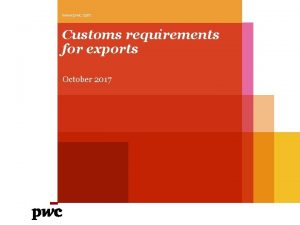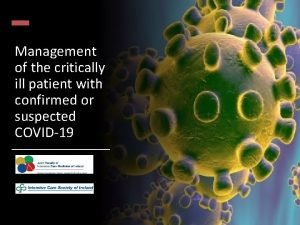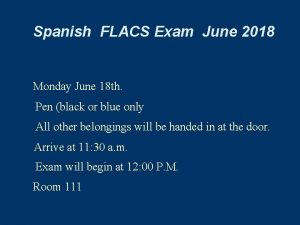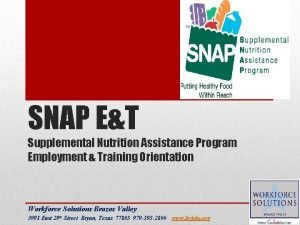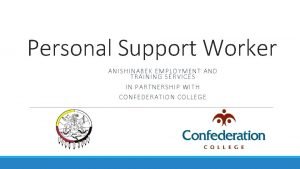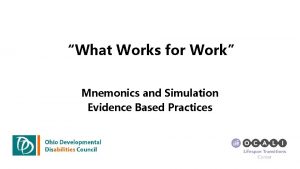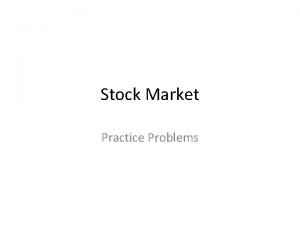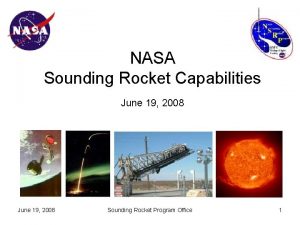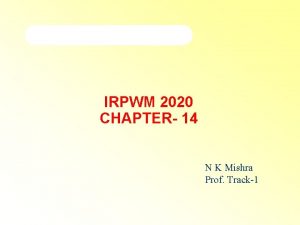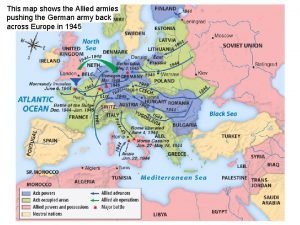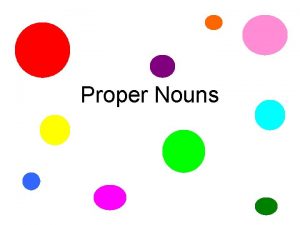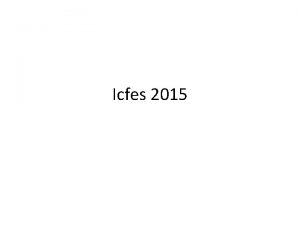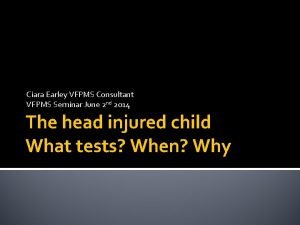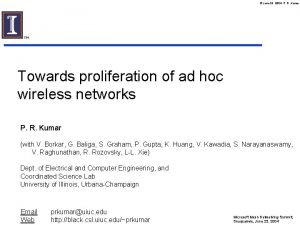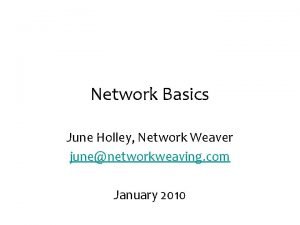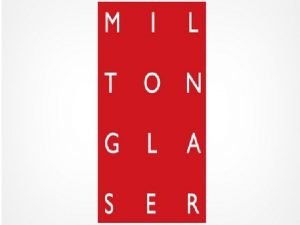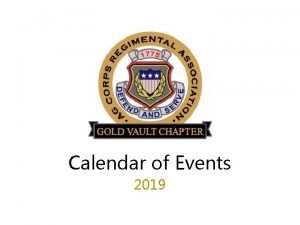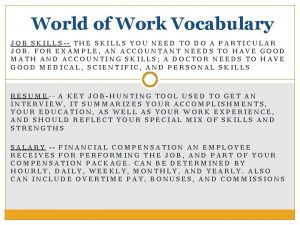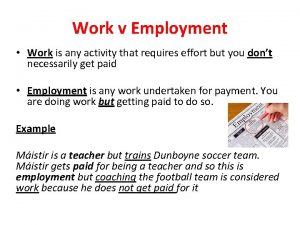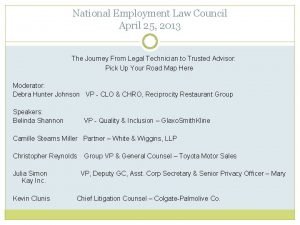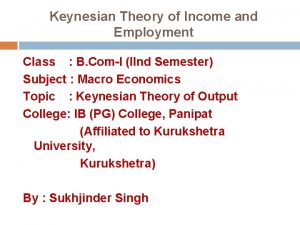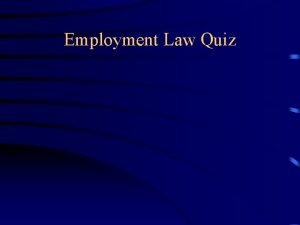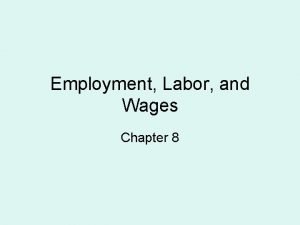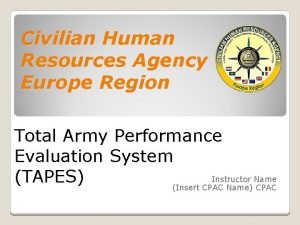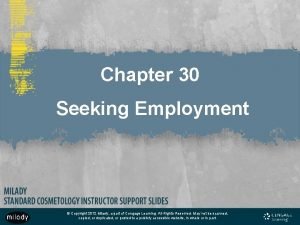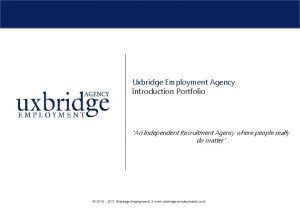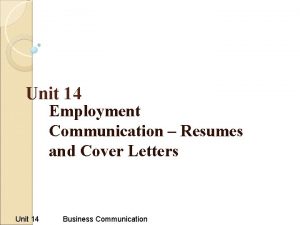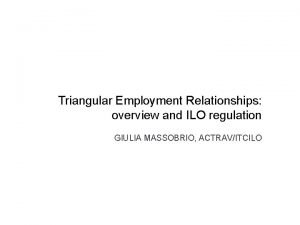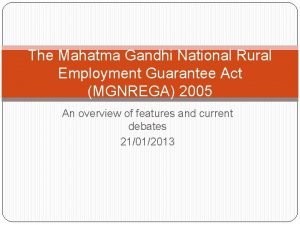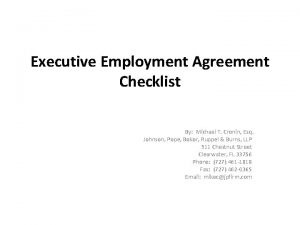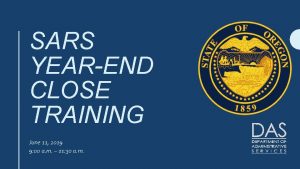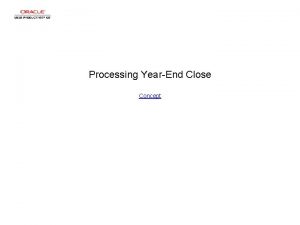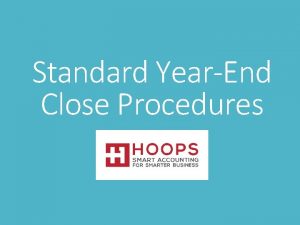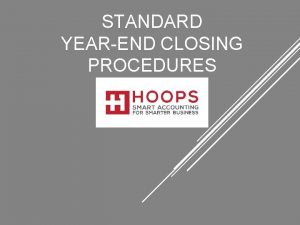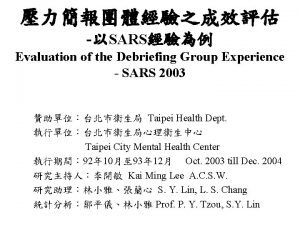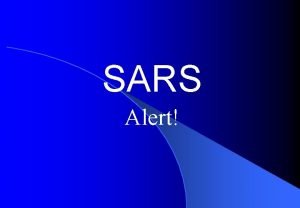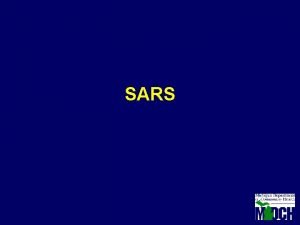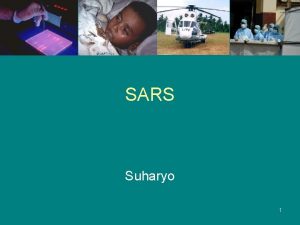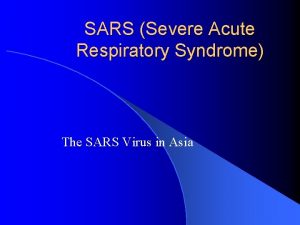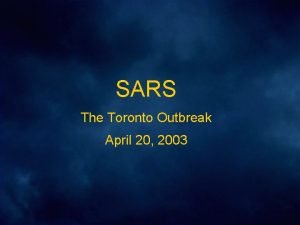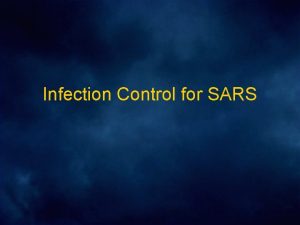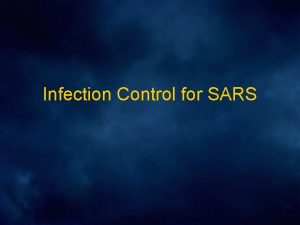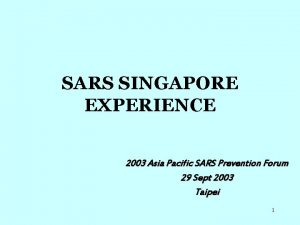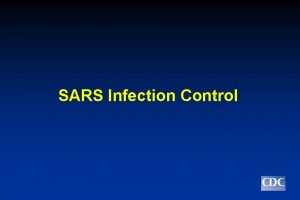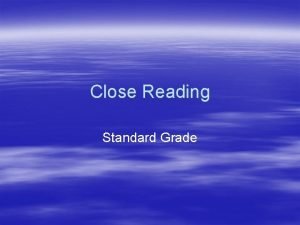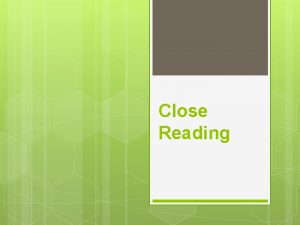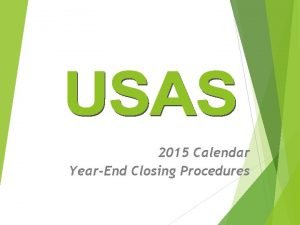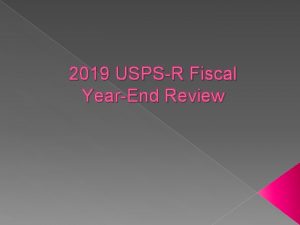SARS YEAREND CLOSE TRAINING June 14 2018 Employment
































































































- Slides: 96

SARS YEAR-END CLOSE TRAINING June 14, 2018 Employment Auditorium 8: 30 a. m. – 11: 30 a. m.

Agenda • What’s New and What’s Coming from SARS – Rob Hamilton • GASB 75 Accounting and Financial Reporting for Postemployment Benefits Other Than Pensions – Shri Vajratkar • GASB 84 Fiduciary Activities – Barbara Homewood • GASB 86 Certain Debt Extinguishment Issues – Sangit Shrestha • GASB 87 Leases – Rob Hamilton • Year-end Schedule – Barb Watson • Disclosure of Restricted Assets – Michael Cutler • Changes to Disclosures – Karen Williams and Sangit Shrestha • Federal Funds Participation (FFP) Reporting – Barbara Homewood • Summary – Rob Hamilton

WHAT’S NEW AND WHAT’S COMING FROM SARS Presented by Rob Hamilton

• Introductions • Key dates and deliverables GASB 68 information – ASAP • GASB 75 information • RHIA and RHIPA – July • PEBB – late July/early August • Compensated absences – July 20 • Securities lending and pension-related debt – July 27 • Communication with DPCUs about outstanding balances (OAM 15. 51. 00) • First communication with DPCUs no later than July 20 • Second communication with DPCUs no later than August 9 • • • This is to provide late-arriving information or to change previously communicated amounts Resolve statewide balances issues with other state agencies by August 3, which is the soft close

• Current Portion of Loans Receivable - **NEW** • • • GL 0431 reports the current portion of the loan GL 0436 reports the allowance for the uncollectible portion of the current portion GL 0931 reports the noncurrent portion of the loan GL 0936 reports the allowance for the uncollectible portion of the noncurrent portion Tcodes 474 and 474 R to reclassify the amounts from GLs 0931 and 0936 to 0431 and 0436, respectively. If you have a balance in GL 0931, our expectation will be that there is a balance in GL 0431

• Noncurrent Accounts Receivable T-code - **NEW SUGGESTION** • When a current A/R is assigned to DOR (or a PCF until 7/1/18), to maintain the account history, use TC 945 for the entire amount assigned to decrease current A/R and increase noncurrent A/R (OAM 15. 35. 00, paragraph 135). • Month 13 FY 2018 • • TC 945 DR GL 3105 – Revenue Control F/S Accrual DR GL 0935 – Other Receivables – Noncurrent CR GL 0503 – A/R Unbilled CR GL 3037 – Nonspendable Fund Balance – Noncurrent Receivables Month 1 FY 2019 TC 946 (Auto-reversal of TC 945) DR GL 0503 – A/R Unbilled DR GL 3037 – Nonspendable Fund Balance – Noncurrent Receivables CR GL 3105 – Revenue Control F/S Accrual CR GL 0935 – Other Receivables – Noncurrent • • OAM 15. 35. 00 will be updated to reflect this suggestion

• Deferred Outflows for Contributions Subsequent to the Measurement Date Comptroller Object 3210 – Public Employees Retirement Contribution • Comptroller Object 3215 – PERS Contribution – RHIA **New CO** • Comptroller Object 3216 – PERS Contribution – RHIPA **New CO** • **NEW PROCESS for agencies with ENTERPRISE and INTERNAL SERVICE funds** • • Pension: 1. 2. 3. • Record the GASB 68 information as instructed from SARS. Contributions subsequent to the measurement date (GL 1005) will be zeroed out. Comptroller object 3210 is not impacted. Record the pension-related debt entries as instructed by SARS, which will reclassify the amounts in comptroller object 3210 to interest expense and a reduction of the related liability. Use Tcode 457 R to reclassify the entire amount remaining in comptroller object 3210 after step 2 to GL 1005. OPEB: 1. 2. Record the GASB 75 information as instructed by SARS. Contributions subsequent to the measurement date (GL 1010) will be zeroed out. Comptroller object 3215 and 3216 are not impacted Use Tcode 457 R to reclassify the entire amount remaining in comptroller objects 3215 and 3216 to GL 1009.

• GASB 81 Irrevocable Split-Interest Agreements Although there are irrevocable split-interest agreements with which state agencies are involved, the amounts are small and SARS has decided not to apply GASB 81 to the agreements. • Beginning in FY 2019, a new agency disclosure will be included, in which N/A is not an option, to ensure that we have the information in case SARS does decide to apply GASB 81 to the agreements. •

• LFO Report on Liquidated and Delinquent Accounts Receivable – Allowance for Uncollectible Accounts • Two new fields for uncollectible accounts receivable information will be added for FY 2018: Number of uncollectible accounts • Balance of uncollectible receivables • • • Determined the same way agencies do for CAFR reporting Balance in LFO Report should be equal to or less than what’s on the agency accounting records as not all accounts receivable are liquidated and delinquent • Both sets of information are submitted to SARS for review May be an opportunity for agencies to reassess their allowance calculations for CAFR reporting, especially if their getting actual data. • LFO report due annually on October 1 •

GASB 75 Presented by Shri Vajratkar

RETIREE HEALTH INSURANCE ACCOUNT - RHIA • Cost-sharing, multiple-employer defined Benefit OPEB plan administered through a trust. • Plan is closed to new entrants hired on or after August 29, 2003. • Payment of up to $60 towards the monthly cost of health insurance for eligible members. • Contributions are actuarially determined as a percentage of payroll. • Net OPEB Asset. • Funds proportionate share of activity based on percentage of total contributions. • All proprietary funds and the GWRF will report their proportionate share of the Net OPEB Asset and activity. • Measurement Date June 30 th 2017. • Beginning in FY 18, all OPEB contributions will be deferred outflows for financial reporting purposes.

RETIREE HEALTH INSURANCE PREMIUM ACCOUNT - RHIPA • Single-employer defined Benefit OPEB plan administered through a trust. • Plan is closed to new entrants hired on or after August 29, 2003. • Pays the average difference between health insurance premiums paid by retirees and those paid by active state employees – only to those retirees who are not eligible for Medicare coverage. • Contributions are actuarially determined as a percentage of payroll. • Net OPEB Liability. • Funds share of activity based on percentage of total contributions. • All proprietary funds and the GWRF will report their share of the Net OPEB Liability and activity. • Measurement Date June 30 th 2017. • Beginning in FY 18, all OPEB contributions will be deferred outflows.

PUBLIC EMPLOYEES BENEFIT BOARD - PEBB • Single-employer defined Benefit OPEB plan NOT administered through a trust. NOT • No Employer Contributions – Pay as You Go Plan. • Implicit Rate Subsidy. • Total OPEB Liability. • Funds share of activity based on percentage of annual health insurance premium costs. • All proprietary funds and the GWRF will report their proportionate share of the Total OPEB Liability and activity. • Measurement Date June 30 th 2018. • No deferred outflows for Contributions subsequent to measurement date.

NEW ACCOUNTS IN SFMA GL Title GLA GL Title 0968 Net OPEB Asset 1775 Net OPEB Liability 1006 D/O – OPEB Diff. in Econ Experience 1857 D/I – OPEB Diff. in Econ Experience 1007 D/O – OPEB Diff. b/w Projected & Actual Earnings 1858 D/I – OPEB Diff. b/w Projected & Actual Earnings 1008 D/O – OPEB Change in Assumptions 1859 D/I – OPEB Change in Assumptions 1009 D/O – OPEB Change in Emp. Cont. & Prop. 1860 D/I – OPEB Change in Emp. Cont. & Prop. 1010 D/O – OPEB Contribution After MD Comp. Object 3215 - PERS Contribution – RHIA Comp. Object 3216 - PERS Contribution – RHIPA Comp. Object 3213 – OPEB Expense – GASB 75

ACCOUNTS TO BE USED IN FY 2018 RHIA RHIPA PEBB Comptroller Object 3215 – PERS 3215 Contribution – RHIA Comptroller Object 3216 – PERS 3216 Contribution – RHIPA N/A Net OPEB Asset – GL 0928 Net OPEB Liability – GL 1775 Total OPEB Liability – GL 1775* D/I of Resources for Difference b/w Projected and Actual Earnings N/A on Invst. – GL 1858 D/O of Resources for Changes in Proportionate Share– GL 1009 N/A D/O of Resources for Contributions Subsequent to Measurement Date – GL 1010 N/A

GASB 84 Presented by Barbara Homewood

Concept of GASB 84 - Establishes criteria for identifying fiduciary activities and guidance on reporting those activities, including clarifying when stand-alone business-type activities should report fiduciary activities. - Effective July 1, 2019 (FY 20) - Exposure Draft is due December 2018

Three types of fiduciary activities o. Fiduciary component units (paragraphs 6 – 9) o. Pension and OPEB arrangements that are NOT component units o. Other fiduciary (paragraph 11) o BOTH of the following must be met: o Government controls the assets (paragraph 12) o Assets are NOT derived from fees, taxes, or investment earnings (para 11 b) And….

In addition, one or more of the following: o Assets administered through a trust (paragraph 11 c 1) • Government itself is not a beneficiary • Assets are dedicated to providing benefits to recipients under benefit terms • Assets are legally protected from creditors of the government o Beneficiaries are individuals and government has no administrative or direct financial involvement (11 c 2) • Assets not derived by fees, taxes, and investment earnings o Beneficiaries are organizations or other governments and the assets are not part of the financial reporting entity (11 c 3) • Assets not derived by fees, taxes, and investment earnings


Four types of Fiduciary funds o. Pension and other employee benefit trust funds o. Investment trust funds o. Private-purpose trust funds o. Custodial funds

Private Purpose Trust Funds o. Fiduciary activities held in trust and are NOT required to be reported as pension, OPEB, or investment trust funds Assets administered through a trust Government itself is not a beneficiary Assets are dedicated to providing benefits to recipients under benefit terms Assets are legally protected from creditors of the government

Custodial Funds o. Report fiduciary activities not held in trust o. Agency funds will be known as custodial funds o. Will include an operating statement • Revenue will be separately identified at gross level Source of inflow such as Restitution Payments Received • Expenditures will be separately identified at gross level Type of outflow such as Distribution to Counties/Cities/ Individual, etc.

What Agencies Need To Do • Determine if an activity qualifies as fiduciary • Use the flowchart • Paragraphs 5 – 13 of statement • Determine which fiduciary fund is correct • Review Private-Purpose Trust Funds • Is there a trust? If not, then Custodial fund • Balances in Custodial Assets (GL’s 0335 and 0945) • Balances in Custodial Liabilities (GL’s 1575, 1576, 1577, 1578)

What Agencies Need To Do – cont. • Ensure profiles are capable of recording revenues and expenditures • Send Appropriation profile requests (20) to orbits. help@state. or. us • Trust/Custodial fund subject to GASB 84 • Include authority to be non-budgeted • Include the current D 23 fund

OAM • More accounting guidance to follow in the OAM • KPMG training on July 12 th • www. kpmg. com/us/governmentinstitute

Questions?

GASB 86 Presented by Sangit Shrestha

Definitions • Debt refunding: The State issues debt and uses the proceeds to repay previously issued debt. • Current refunding: New debt used to redeem the existing debt within 90 days of issuance. • Advanced refunding: Proceeds held by escrow for future payments. • In-substance defeasance: Debt is considered defeased “in-substance” if all of the following conditions apply: • • • The placement of the resources in escrow is irrevocable. Escrow resources can be used only for the scheduled debt service payments on the old debt. The possibility of the State having to make future payments on that debt is remote. All escrow resources are monetary and essentially risk-free. Cash flows approximately coincide as to timing and amount with scheduled debt service payments.

GASB 86 Certain Debt Extinguishment Issues 1. Establishes accounting and financial reporting requirements for in-substance defeasance of debt using existing resources other than the proceeds of refunding debt. 2. Include remaining prepaid insurance associated with debt that is extinguished in the net carrying amount of debt for purpose of calculating the gain or loss on refunding. This applies to all refundings. 3. Substitution of essentially risk-free investments with not essentially risk-free investments in subsequent periods would reverse in-substance defeasance accounting. 4. Effective FY 2018.

GASB 86 Certain Debt Extinguishment Issues – Changes in Agency Disclosures

GASB 86 Certain Debt Extinguishment Issues Changes in Agency Disclosures continued

GASB 86 Certain Debt Extinguishment Issues Entries Example: Existing Bond: Bonds payable – noncurrent: $90, 000. 00 Unamortized discount as of date of defeasance: $2, 000. 00 Remaining Prepaid Insurance: $1, 200. 00 Agency cash payment to escrow to defease debt (using existing resources): $100, 000. 00

GASB 86 Certain Debt Extinguishment Issues Entries • TC 167 R Record payment to escrow from existing resources. - DR 3500 Expend Cntrl–Cash 100, 000. 00 (C/O 4051 Bond Refund Debt Pmt) - CR 0065 Unreconciled Deposit • Governmental fund 100, 000. 00

GASB 86 Certain Debt Extinguishment Issues – Entries - continued • • • TC 528 Eliminate defeased debt. - DR 1714 Bonds Payable - Noncurrent - CR 3600 GAAP Expend Offset (C/O 4051 Bond Refund Debt Pmt) TC 514 R Eliminate discount related to defeased debt. - DR 3600 GAAP Expend Offset (C/O 4051 Bond Refund Debt Pmt) - CR 1712 Discount on Bonds Sold Government-wide Reporting Fund 90, 000. 00 2, 000. 00

GASB 86 Certain Debt Extinguishment Issues – Entries - continued • TC 514 R Eliminate prepaid insurance related to defeased debt. - DR 3600 GAAP Expend Offset 1, 200. 00 (C/O 4051 Bond Refund Debt Pmt) - CR 0602 Prepaid Expense • Government-wide Reporting Fund 1, 200. 00

GASB 86 Certain Debt Extinguishment Issues – Entries - continued Agencies must calculate gain or loss as follows: Face value of refunded debt $90, 000 Discount on refunded debt Prepaid Insurance Net carrying amount (2, 000) (1, 200) 86, 800 Payment to escrow agent Loss on refunding 100, 000 (13, 200)

GASB 86 Certain Debt Extinguishment Issues – Entries - continued TC 113: To record loss on refunding. - DR 1714 3200 GAAP Revenue Offset (C/O 2317 Gain/Loss on Refunding) - CR 3060 Prior period adjustment • TC 114: To reclassify Bond Refund Debt Payment. - DR 3060 Prior period adjustment - CR 3600 GAAP Expend Offset (C/O 4051 Bond Refund Debt Pmt) • • Government-wide Reporting Fund 13, 200. 00

Questions?

GASB 87 Presented by Rob Hamilton

GASB 87 Leases • Effective for periods beginning after 12/15/2019 – FY 2021 for the state • Exposure draft to come about January 2019 • Agencies must be ready by July 1, 2020 as operating activity will need to be recorded throughout the year • GASB 87 establishes a single model for lease accounting based on the foundational principle that leases are financings of the right to use an underlying asset. No more operating or capital leases • Most similar to a capital lease, but not the same • • A lease is a contract that conveys control of the right to use another entity’s nonfinancial asset (the underlying asset) as specified in the contract for a period of time in an exchange or exchange-like transaction Underlying asset does not have to be a capital asset • As a “contract” , the lease, whether written or verbal, be legally enforceable •

GASB 87 Leases • Exclusions from the accounting required by this standard: • If, at the beginning of the lease term, the maximum possible term of the lease is 12 months or less, including any options to extend, regardless of their probability of being exercised • • Noncancelable portion only. Month-to-month leases are cancelable Contracts that transfer ownership by the end of the contract period (even if called a “lease”) Account for this as a financed purchase or sale • The existence of a bargain-purchase option does not trigger this exclusion – it must be exercised • • • Leases of intangible assets, including licensing contracts for computer software Leases of biological assets (timber, plants, animals) Leases of assets that are investments Supply contracts Leases of inventory Service concession arrangements Certain regulated leases (specific criteria, airport/aviation leases are the example) Leases in which the underlying asset is financed with conduit debt, unless both are reported by the lessor

GASB 87 Leases • Lease term – noncancelable portion plus/less options that are “reasonably certain” of being exercised • Lessee (economic resources measurement focus): • Debit intangible right-to-use leased asset (a capital asset) Equal to the lease liability + lease payments made prior to lease term – lease incentives received from lessor + direct ancillary costs to place the leased asset into service • Amortize over the shorter of lease term or useful life of leased asset (generally) • • Credit lease liability • Present value of payments expected to be made during the lease term 1. 2. • • First use interest rate the lessor charges the lessee If #1 cannot be readily determined by lessee, use estimated incremental borrowing rate Reduced by payments made to lessor (principal portion only) For governmental funds (current financial resources measurement focus): Other financing source and expenditure in first year – just like debt issuance • Subsequent payments – same treatment as debt service payments •

GASB 87 Leases • Lessor: • Debit lease receivable – applies to governmental funds too • Present value of payments expected to be received during the lease term Discount using the interest rate charged by the lessor to the lessee • No other option provided for discounting • • • Reduced as payments are received from lessee (principal portion only) Credit deferred inflow of resources – applies to governmental funds too Equal to the lease receivable + lease payments received prior to the lease term that relate to future periods – lease incentives paid • Amortize over the lease term • • Lessor continues to recognize the asset being leased to the lessee and apply other applicable guidance to the underlying asset, including depreciation and impairment • If lessee must return the asset in its original or enhanced condition – do not depreciate

GASB 87 Leases • Contracts that contain a lease component and a nonlease component must be accounted for separately, unless an exception applies • • i. e. the contract covers access to a building (lease) and maintenance services on the building (nonlease) If a lease involved multiple underlying assets, which have different lease terms, each underlying asset should be accounted for as a separate lease (lessor/ee) • Lessee should also do this if multiple asset classes are covered by the lease • • Consider in conjunction with contract combinations (next slide) Exception: If contract does not identify cost of separate underlying assets, or if those prices appear unreasonable: Use professional judgment to estimate and allocate to the underlying assets (components), maximizing observable information 2. If #1 is not practical for some or all underlying assets (components), account for the contract as a single lease 1. • Accounting should be based on primary underlying asset’s components (i. e. lease term)

GASB 87 Leases • Contract combinations • Contracts that are entered into at or near the same time with the same counterparty should be considered part of the same contract if either of the following are met: The contracts are negotiated as a package with a single objective • The amount paid in one contract depends on the price or performance of the other contract • • Still need to consider whether the lease needs to be separated into its components as discussed in the previous slide

GASB 87 – What Agencies Need to Know and Do • LFO, OST, DAS CF&P Information Request on Current Operating Leases • Operating leases with commitments longer than 20 years: Does it have a fiscal funding clause? 1. a. b. For those that do, an aggregated “yes” is sufficient and no more information is needed. For those that do not, for each lease, provide a brief description about the lease. The Oregon Constitution requires LFO approval for debt beyond 20 years, and operating leases without fiscal funding clauses are debt for this purpose. • Nationally, there is growing interest from stakeholders about debt • LFO has asked that information start coming to SARS from agencies in January or February of 2019. Formal ask to be coming in the not-too-distant future. •

GASB 87 – What Agencies Need to Know and Do • Start reviewing your leases as soon as you can and determine: • • • Do any of the exclusions apply to your current operating leases? Does the lease include an explicit discount rate? What’s the lease term? What about options to extend and their likelihood? Does the lease also contain nonlease components, such as for maintenance? Does the lease cover multiple underlying assets that need to be separated? • Begin working through the accounting • Read GASB 87 (www. gasb. org) • Attend trainings – KPMG will have two in fall 2018 (www. kpmg. com/us/governmentinstitute) • Expect the implementation of this to take time – plan ahead! Be ready for July 1, 2020! • More accounting guidance to follow in future OAMs and trainings!

Questions?


YEAR-END SCHEDULE Presented by Barb Watson

Due Date Reminders Ø Agency disclosures due Friday, August 17 (Gold Star Date) Ø SEFA disclosures due Friday, August 17 (Gold Star Date) Ø Schedule of Key Dates Ø http: //www. oregon. gov/das/Financial/Acctng/Pages /Yr-end-cls. aspx 52

R*STARS Reports Year -end Schedule Ø Close of June is July 13, at which point there will be a full report run Ø During Month 13 (July 16 - Aug 10), agencies can request various R*STARS reports, which run each Tuesday evening Ø SFMA Calendar: http: //www. oregon. gov/das/Financial/Acct g. Sys/Documents/2018 agy. pdf 53

Datamart Tables Update Schedule Updates over the weekend Ø GL Detail Table Ø GL Summary Table Ø All Accounting Event Table YE Tables – Contain FY 2018 data only Ø Ø Updates Tuesday/Thursday/Saturday evenings during Month 13 Ø YE GL Detail Table Ø YE GL Summary Table Updates the final three Wednesday evenings of Month 13 Ø Ø YE Accounting Event Table Repository Reports with “YE” in the title and the SWB Reports update on the same schedule. 54

DAFR 6610 YE Period 13 Operating Statement DAFR 6610 YE Period 13 55

DAFR 6620 YE Period 13 Balance Sheet DAFR 6620 YE Period 13 56

Statewide Balance (SWB) Reports Ø Same update schedule as the YE Tables Ø SWB Report Schedule and Reports Ø Website: Ø http: //www. oregon. gov/das/Financial/Ac ctng/Pages/Balancing. aspx Ø No update messages will be sent out during Month 13 57

Statewide Balance (SWB) Reports 58

Resources for Month 13 Ø Agency Guide to Year-end Closing Ø http: //www. oregon. gov/das/Financial/Acctng/Pages/Yrend-cls. aspx Ø Checklist located at Section D. 10 Ø Instructions to access repository reports at Section D. 4 Ø Datamart ad hoc queries and repository reports Ø R*STARS reports Ø Statewide balancing reports Ø Prior year closing entries and disclosures Ø Chapter 15 of the Oregon Accounting Manual Ø SARS Analyst 59

July 2018 Sun 8 15 Mon 9 16 Begin using YE Period 13 Datamart reports Tues 10 17 Wed 11 18 Thur 12 19 SWB / SFMA YE updated Fri Sat 13 14 Close Mo 12 SFMA upload 20 21 SWB / SFMA YE updated 22 23 SWB / SFMA YE updated 24 25 26 27 SWB / SFMA YE updated YE Acctg Event table updated SWB / SFMA YE updated 28 60

August 2018 Sun 29 Mon 30 Tues 31 SWB / SFMA YE updated 5 6 7 SWB / SFMA YE updated 12 13 Start using Period 13 Datamart reports w/o YE 14 Wed Thur Fri 1 2 3 SWB / SFMA YE updated YE Acctg Event table updated Soft Close 8 9 10 SWB / SFMA YE updated YE Acctg Event table updated Close Mo 13 16 17 15 Sat 4 SWB / SFMA YE updated 11 SWB / SFMA YE updated Disclosures due to SARS (General, Debt, SEFA) 18 61

RESTRICTED ASSETS Presented by Michael Cutler

Restricted Assets – What are they? ØAssets whose use is subject to constraints that are either: ØExternally imposed by ØCreditors (debt covenants) ØGrantors ØDonors ØLaws and/or regulations of OTHER governments

Restricted Assets - What are they? (continued) OR ØImposed by law through ØConstitutional provisions ØEnabling legislation ØAND ØThe constraints change the nature or normal understanding of the availability of those assets

Nature or Normal Understanding of Availability ØIs there a restriction for the use of the asset? ØIs the asset available for regular operational uses? ØIs there a restriction that means that the asset won’t be used in the next operational period? ØCan you only use interest earnings but maintain the principal amount?

Enabling Legislation ØEnabling legislation “authorizes the government to assess, levy, charge or otherwise mandate payment of resources (from external resource providers) and includes a legally enforceable requirement that those resources be used only for the specific purposes stipulated in the legislation. ” GASB 34, paragraph 34

Restricted Assets vs. Restricted Net Position ØRestricted assets often will NOT tie to Net Position – Restricted ØNet Position – Restricted includes liabilities in the total ØIn some cases, Restricted Assets are offset by liabilities in the fund – ØThat means that there could be NO effect on net position, but still have restricted asset balances

Changes in Disclosure 2. Restricted Cash and Investments ØIn the GL Account column we added GLs 0230 Investments – OITP and 0235 Investment Valuation Account – OITP ØWe are now asking for the D 23 fund detail for restricted Cash and Investments, instead of just GAAP Fund. ØWe also ask if the restricted cash is current or noncurrent

Current vs. Noncurrent ØCurrent = expected to be used within one year for the reason for the restriction ØCash used to pay debt service principal and interest in the next year ØCash accumulated to pay claims for the next year ØNoncurrent = expected to be used over one year out for the reason of the restriction ØCash accumulated to pay future fiscal year debt service ØCash accumulated to pay legal claims in future years, more than one year away


CHANGES TO DISCLOSURES Presented by Karen Williams and Sangit Shrestha

What’s new? – Disclosure forms updated to Adobe Acrobat DC – Do you have an older version of Acrobat? – If YES - Please volunteer to do a short, 2 -3 page test for compatibility. – Contact Karen. A. Williams@oregon. gov

What’s new? -continued B. INSURANCE RECOVERIES 4. Does the insurance recovery relate to a loss incurred in FY 2018? Yes No If Yes, enter the GAAP object (D 08) used to record the loss (if expenditures cover multiple GAAP objects, please attach a spreadsheet. ) D. COMPONENT UNITS Significance means the individual organization has assets that exceed $3, 000 or revenues that exceed $1, 000. If the balances are less than these amounts, do not include.

What’s new? -continued 1. Cash and Investments Applies to 1. A – D and 1. L

What’s new? -continued 2. Restricted Cash and Investments GLs added: 0230 – Investment-OITP 0235 – Investment Valuation-OITP

What’s new? -continued Disclosure 12 – now states that no lease agreement between state agencies should be included, previously specified just office space. Disclosure 13 –column added for Total from Funding Sources Disclosure 15 – now in GAAP Object order SEFA Disclosures – reminder to submit Repository reports with information saved SEFA Disclosure 3 – updated Federal reference from OMB Circular A-133 to Title 2 CFR Part 200

What’s new? -continued – Debt – Disclosure 2 a – Debt – Disclosure 2 b

Good news! No duplicate pdf. / Excel forms – In Excel Format Only! – General Disclosures – Debt Disclosures – 10 – Capital Leases – 2 – General Obligation Bonds – 12 – Leases – 3 – Revenue Bonds – 13 – Construction Contract Commitments – 4 - Cert. of Participation – 14 – Other Commitments – 22 – Changes in Fund Equity – 23 – Prior Period Adjustments – 24 – Cumulative Effect of Change in Accounting Principle – 7 – Refundings of Debt – 8 – Defeased Debt


Excel Disclosures

Excel Disclosures – cont.

Excel Disclosures – cont. – https: //www. oregon. gov/das/Financial/Acctng/Pages/Disc. aspx

Last bits…. – Use correct signage for all disclosures – Fill in Agency number on first page of grouped forms, the rest will populate – In pdf. – Tab or mouse click to navigate – If you have Acrobat version older than DC, contact Karen to test – In Excel – Watch for tabs within workbooks – Navigation works with tab, mouse click, or enter

Last bits…. cont. – Disclosures sent to agencies the first Monday of Month 13. – Completed disclosures and certifications returned before close of business Friday, August 17.

Principal Savings Summary COP 2007 B Original Principal COP 2007 B Unrefunded Principal Date on 5/25/2016 Amount 6, 330, 000. 00 960, 000. 00 COP 2007 B Principal Refunded on 5/25/2016 5, 370, 000. 00 XI-Q 2016 G Refunding Principal on 5/25/2016 4, 740, 000. 00 Savings on Principal on 5/25/2016 Debt Service(P+I) Savings Summary Date Amount 1, 469, 300. 00 1, 232, 850. 00 COP 2007 B Original Debt Service 2015 -17 COP 2007 B Unrefunded Debt Service 2015 -17 COP 2007 B Debt Service Savings 2015 -17 236, 450. 00 XI-Q 2016 G Refunding Debt Service 2015 -17 202, 626. 67 Debt Service Savings 2015 -17 33, 823. 33 Debt Service Savings 11/1/2017 - 11/1/2032 755, 075. 00 Total Savings 630, 000. 00 788, 898. 33 Net PV Savings (based on "all-in TIC") Average coupon of refunded bonds Average coupon of the Series replacement coupons All-In TIC $ 635, 735. 58 4. 426615% 4. 682277% 2. 460862%

Questions?

FEDERAL FUNDS PARTICIPATION (FFP) REPORTING Presented by Barbara Homewood

FFP Certification • New for FY 2018 • Timely review of data • This is to certify that I have reviewed the methods used to calculate the fiscal year 2018 federal funds participation rates submitted herewith and to the best of my knowledge and belief:

Certification Statements 1. All submitted information is true and correct. Documentation has been maintained and is available upon request. 2. All sources of federal funds were used in the calculation. This includes funds received directly from the federal government and federal funds received as another source—including State agencies. 3. All FFP rate changes from fiscal year 2017 to fiscal year 2018 that were 10 percentage points or greater and the percent change was 20% or greater were reviewed and have been determined to be appropriate.

Examples • First example, in fiscal year 2017 the FFP rate was 45% (0. 4500) and in fiscal year 2018 the FFP rate is 35% (0. 3500). There was a 10 percentage point change (45% - 35%) and the percent change was 22% (10/45 =. 22). This scenario would warrant a closer or second review because both conditions were met. • Second example, in fiscal year 2017 the FFP rate was 45% (0. 4500) and in fiscal year 2018 the FFP rate is 36% (0. 3600). There was a 9 percentage point change (45% - 36%) and the percent change was 20% (9/45 =. 20). This scenario would not necessarily need a closer or second review because both conditions were not met.

Fourth Statement and More 4. No FFP rate is greater than 100% or less than 0%. …and more… • Programs where no federal funds can be used • For example, State Police Security • Specifically prohibited in Uniform Guidance • Signed by the person who can take responsibility for accuracy • Due by August 22, 2018

Questions

SUMMARY Presented by Rob Hamilton

New noncurrent A/R process allows the history of the receivable assigned to DOR to be maintained • Complete communication with DPCUs on time • For proprietary funds, reclassify CO 3210 amounts after pension-related debt information is recorded • There are three separate OPEB plans – so three different sets of entries • Review your fiduciary activities: • • • Does a trust exist? Ensure the 20 profiles are set up for agency funds Need to be ready by July 1, 2019 Review your leases: • • • Do any of the exclusions apply to your current operating leases? Does the lease include an explicit discount rate? What’s the lease term? What about options to extend and their likelihood? Does the lease also contain nonlease components, such as for maintenance? Does the lease cover multiple underlying assets that need to be separated? Need to be ready by July 1, 2020

• Information is available much more frequently during Month 13 – check the calendar • Review your restricted asset information – does it need to be updated in light of the training? • Excel disclosures this year! • Remember the proper sign when completing your disclosures • Sign the FFP certification • Questions?

Thanks for coming! Training will be available on our website soon Please complete an evaluation of this training on i. Learn Have a Great Year-end! SARS Webpage: https: //www. oregon. gov/das/Financial/Acctng/Pages/Index. aspx
 Sars customs worksheet
Sars customs worksheet Rass
Rass Spanish flacs exam 2018 answers
Spanish flacs exam 2018 answers June 21 2019 geometry regents
June 21 2019 geometry regents Flacs checkpoint b french exam
Flacs checkpoint b french exam Cxc 2018 results
Cxc 2018 results June 2018 chemistry regents
June 2018 chemistry regents Dada la siguiente secuencia rusia 2018 rusia 2018
Dada la siguiente secuencia rusia 2018 rusia 2018 Snap employment and training program texas
Snap employment and training program texas Employment training panel sacramento
Employment training panel sacramento Anishinabek employment and training services
Anishinabek employment and training services Gila river employment and training
Gila river employment and training 30 days has september april june and november
30 days has september april june and november June 2010 physics regents answers
June 2010 physics regents answers June 2005 calendar
June 2005 calendar To a daughter leaving home and poem for my sister
To a daughter leaving home and poem for my sister Good morning 1 june
Good morning 1 june Corn be heavy soon
Corn be heavy soon June 2010 chemistry regents answers
June 2010 chemistry regents answers Welcome june blessings
Welcome june blessings English paper 1 june 2021
English paper 1 june 2021 Grade 7 life orientation term 1 notes
Grade 7 life orientation term 1 notes Good morning welcome june
Good morning welcome june French music awards
French music awards I like school poem by lenore hetrick
I like school poem by lenore hetrick June cheetah wegener
June cheetah wegener Lottery in june corn be heavy soon
Lottery in june corn be heavy soon June canavan foundation
June canavan foundation June's portfolio includes 177 shares
June's portfolio includes 177 shares 19.06.2008 nasa
19.06.2008 nasa Irpwm 2020
Irpwm 2020 June 20 2008
June 20 2008 Cartoon in german
Cartoon in german June's journey
June's journey Good morning please
Good morning please Flacs writing rubric
Flacs writing rubric Summary period: june 2021 poem
Summary period: june 2021 poem Battle of midway june 1942
Battle of midway june 1942 Harry potter is common noun or proper noun
Harry potter is common noun or proper noun Elephant riding in phuket respuestas
Elephant riding in phuket respuestas June too soon july stand by
June too soon july stand by Ciara earley
Ciara earley Uncle of jose rizal who was a lover of books.
Uncle of jose rizal who was a lover of books. June 22 to july 22
June 22 to july 22 June 6 1944
June 6 1944 June budhooram
June budhooram 1215 king
1215 king June preschool newsletter
June preschool newsletter June 23
June 23 Dr june carroll
Dr june carroll Tsc timetable
Tsc timetable June safety tips
June safety tips June 23
June 23 January february march april may june july
January february march april may june july Nysedregents chemistry
Nysedregents chemistry Prayer for june
Prayer for june Holy june
Holy june Companies in june
Companies in june 1 june children's day
1 june children's day Head start of greater dallas
Head start of greater dallas Dr june james
Dr june james Network weaver
Network weaver Milton glaser biography
Milton glaser biography June ward
June ward 2019 june calendar
2019 june calendar Training is expensive without training it is more expensive
Training is expensive without training it is more expensive Perbedaan on the job training dan off the job training
Perbedaan on the job training dan off the job training Aggression replacement training facilitator training
Aggression replacement training facilitator training The world of work vocabulary
The world of work vocabulary What is employment activity
What is employment activity Creighton student employment
Creighton student employment Employment readiness scale
Employment readiness scale Short run phillips curve
Short run phillips curve Gpisd calendar
Gpisd calendar Nsz kragujevac
Nsz kragujevac Psp pre employment screening
Psp pre employment screening Ommaverify.ok.gov
Ommaverify.ok.gov National employment law council
National employment law council Explain the keynesian theory of employment
Explain the keynesian theory of employment Keynesian and classical theory
Keynesian and classical theory Brelje and associates
Brelje and associates Northwest isd jobs
Northwest isd jobs Grk engineering
Grk engineering Employment law quiz
Employment law quiz Chapter 8 employment labor and wages
Chapter 8 employment labor and wages Total army performance evaluation system
Total army performance evaluation system Chapter 30 milady
Chapter 30 milady Bame barriers to employment
Bame barriers to employment Dg employment
Dg employment Legacy link senior employment
Legacy link senior employment Uxbridge
Uxbridge Employment communication
Employment communication Triangular employment
Triangular employment Employment readiness scale assessment
Employment readiness scale assessment Employment guarantee scheme 1972, *
Employment guarantee scheme 1972, * Overcoming barriers to employment
Overcoming barriers to employment Executive employment agreement checklist
Executive employment agreement checklist
